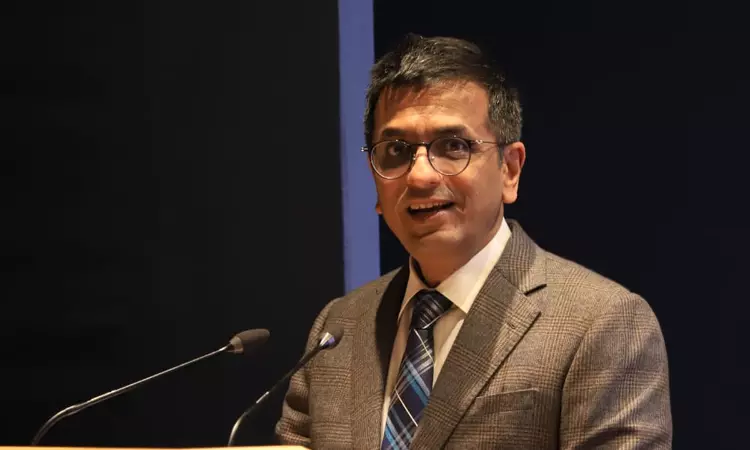- Home
- /
- Top Stories
- /
- Holding CLAT Only In English Makes...
Holding CLAT Only In English Makes Legal Profession Biased Against Rural & Marginalised Persons: CJI DY Chandrachud
Suraj Kumar
26 Nov 2023 4:43 PM IST
In a commemorative event marking the centenary of Dr. B.R. Ambedkar's law practice, Chief Justice of India DY Chandrachud pointed out the challenges faced by individuals from marginalised backgrounds in the legal profession. “They don't have social, or cultural capital or access to resources. Example- Coaching centres", he said. Pointing out that people from marginalised backgrounds are...
In a commemorative event marking the centenary of Dr. B.R. Ambedkar's law practice, Chief Justice of India DY Chandrachud pointed out the challenges faced by individuals from marginalised backgrounds in the legal profession.
“They don't have social, or cultural capital or access to resources. Example- Coaching centres", he said. Pointing out that people from marginalised backgrounds are not conversant in English, CJI DY Chandrachud referred to the Common Law Admission Tests, which which are entirely conducted in English.
"Our CLAT examination, which is the bedrock for entering the legal profession, is entirely conducted in English. Now, with the very fact that the medium of examination is in English, we are making our profession urban-centric and wholly and completely biased against those who come from rural or marginalised backgrounds".
In this connection, it is relevant to note that a PIL is pending in the Delhi High Court seeking to hold the CLAT in regional languages. Recently, the Bar Council of India supported the holding of CLAT in regional languages and offered to conduct the test. The National Testing Agency has also told the High Court that it can hold CLAT in regional languages.
CJI Chandrachud also criticized the discriminatory practice of selecting clerks only from national law schools and described how a white paper was prepared, submitted, and implemented to reorient the clerkship scheme. He also highlighted collaborative efforts between the Supreme Court and the National Commission for Scheduled Tribes (NCST) to launch modulated and structured internship programs. These initiatives aimed to address concerns raised by the NCST about the lack of engagements for tribal students.
Ambedkar belongs to all
At the event organised at the Supreme Court, CJI Chandrachud highlighted the profound impact of Dr. Ambedkar's efforts, transcending his historical role as a leader of the untouchables.
“Dr. Ambedkar really belongs to all of us. Gone are the days when we can say that the people call him the leader of the untouchables. The more one reflects on his life and teachings, one realizes that his efforts were not only to bring social reform or mobilize his own people, but his efforts were to reform Indian society itself.”
He added “Bringing social justice to the marginalized is not the project of the marginalized alone. Just like bringing gender justice is not a project for only just for women but it is a project for all of us. In that sense, I think we are all reforming ourselves and healing ourselves in our effort to heal society.”
Referring to the statue of Dr.Ambedkar which was unveiled by President Droupadi Murmu earlier in the day as par of the Constitution Day celebrations, CJI Chandrachud said that it was a symbol of the enduring quest for equality. "Liberty would only be a hoax if there's no equality and fraternity," he said.
On the Constitution Day, the Supreme Court's webpage added a special section about Dr.Ambedkar. The webpage has details of his life, the cases argued by him, links to his important speeches (including an audio of his CAD speech), photos etc.
Can we say the legal profession is truly inclusive or is based on networks?
During his address, CJI posed critical questions about inclusivity within the legal profession, urging introspection on whether the profession truly operates on a level playing field.
“Can we all say with a hand in heart that it is truly inclusive or based on networks? How are young lawyers admitted into chambers? Is there a level playing field? There are extraordinarily talented individuals but they require mentorship.”
“Have we created an inclusive institution? We need to see what obstacles they facing. These are duties which are cast on all of us. What steps do we take to make it into a more inclusive profession? What kind of mentorship has enabled them to succeed? Obviously, there are people who have succeeded. How were they able to overcome the condition of discrimination?
On Underrepresentation of Women in Higher Judiciary
Elaborating on the underrepresentation of women in the higher judiciary, CJI Chandrachud said that it reflected the state of gender representation which was there in the legal profession a decade or two ago. Because, the judges can be elevated to the higher judiciary only from the pool which is available at present.
However, he expressed optimism about the future by highlighting the increasing number of women judges in the district judiciary, which will eventually get reflected in the higher judiciary in the coming years.
“When it comes to the district judiciary, in several states- over 80% of fresh recruits are women, even 60%, 70%.."
Also Read - All India Judicial Service Can Select Brilliant Youngsters For Judiciary : President Droupadi Murmu


